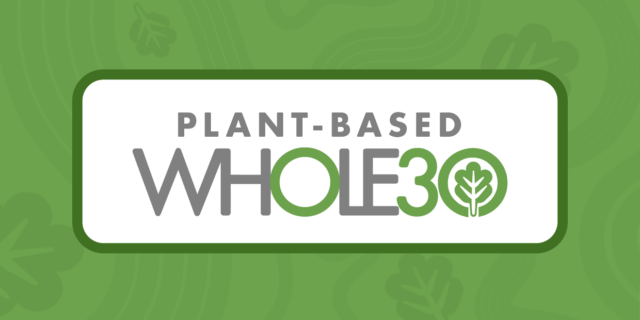In this special series, Registered Dietitian Stephanie Greunke answers your questions about the Plant-Based Whole30. Today, she’s replying to someone who has done the Original Whole30 with great success, but is now experimenting with a plant-based approach, and wondering if their experience on the Plant-Based Whole30 will be just as beneficial.
Ask the RD: “I’ve done the Original Whole30 with great success, when I ate meat. Now, I’m exploring being a vegan, and plan to start the Plant-Based Whole30 next month. Should I expect to have a similar experience, and will I see the same benefits?” –Going Green
Dear Going Green,
I wish I could give you a quick and definitive answer, but there is a lot of nuance here. Whole30 is all about empowering you through our program and community to make positive and sustainable health changes. However, we’ve been transparent in our messaging that the Plant-Based Whole30 program isn’t for everyone. So it’s hard for me to say whether it will work equally well as the Original Whole30 for you.
For some, the Plant-Based Whole30 is a fantastic opportunity to fine-tune your vegetarian or vegan diet. And do it in a way that is even more health-promoting. Some participants thus far have noticed significant improvements in their skin, digestion, energy, and mood.
In addition, healthcare practitioners recommend the program to their patients as a thoughtful way to approach a plant-based diet. The Plant-Based Whole30 can help you learn which plant-based foods work best for you. It also teaches you how to balance your plate with a healthy amount of plant-based protein and fat for your context.
For others, however, your Plant-Based Whole30 may show you that a 100% plant-based approach isn’t a good fit for your body or health goals. Let’s explore why people can have such different experiences. And see why the Plant-Based Whole30 “not working” for some actually means it did work, arming you with the specific information you need to best determine the right approach for your Food Freedom.
Contraindications for a Plant-Based Whole30
Before you begin, here are three specific contexts in which we would not recommend you try the Plant-Based Whole30. That’s because it would most likely lead to a loss of health status and/or increase in negative symptoms:
1. Are you allergic to soy or peanuts, or do you have an intolerance to other legumes?
If you answered yes, we do not recommend you try the Plant-Based Whole30 program, as it likely won’t be effective or healthy for you. Soy and other legumes are prominent sources of plant-based protein on this version of the program. So individuals with legume allergies or sensitivities often find they actually feel worse on a Plant-Based Whole30.
Furthermore, if you eliminate soy and legumes from your plant-based meal template, that doesn’t leave you many options for consuming adequate daily protein. You’d have to rely on plant-based protein powders (like pea, pumpkin, and sunflower) and compatible meat alternatives (like Abbot’s Butcher “Chorizo”) as your primary protein sources. It would be challenging to consume enough every day. (This also goes against our recommendation to eat primarily whole food plant-based protein sources on the program.)
2. Are you on a low-FODMAP diet or navigating a GI condition like SIBO (Small Intestinal Bacterial Overgrowth)?
If you answered yes, the Plant-Based Whole30 is likely not a good option for you. Unfortunately, many prominent plant-based protein sources, like legumes and lentils, are extremely high in FODMAPs. Also, the high fiber content of a 100% plant-based approach may aggravate conditions like SIBO. Please work with your healthcare practitioner to resolve any underlying gut conditions before attempting a Plant-Based Whole30.
3. Are you pregnant or nursing, or looking to include a child in your Plant-Based Whole30?
During pregnancy and nursing, the body has increased nutrient needs, including protein. The same is true of growing children and adolescents. For these reasons, we do not recommend the Plant-Based Whole30 for those who are pregnant or nursing, or children. Always consult your healthcare provider before you or your family begin any new dietary or lifestyle program, especially if this is your context.
Other contexts, for consideration
If you don’t have any of the above reasons for abstaining (and your healthcare provider has green-lighted our dietary program for you) here are two things to consider that can help you predict (a bit, at least) how well the program may or may not work for you:
1. Does your current “plant-based” diet include eggs and/or seafood, consumed regularly?
If the answer is yes, you may struggle to adapt to the amount of legumes and/or soy required on a 100% plant-based approach. It’s likely you’ve been supplementing your daily protein needs with at least some animal protein, and that won’t be available to you during your Plant-Based Whole30. Some find the addition of more soy and legumes all at once troublesome for digestion or inflammation. But we’ll share tips below to help you try to counteract these potential effects.
2. Are you an athlete, manual laborer, or someone with higher protein needs?
If you answered yes, you may struggle getting adequate protein on a 100% plant-based program. While it’s possible to meet your protein needs on the Plant-Based Whole30, it’s definitely more challenging. That’s especially true for those who:
- require more protein to meet their fitness goals
- have been told to consume more protein by their healthcare provider
- simply feel and perform better with a higher protein intake
If you fall into one of these categories, you may struggle to eat enough daily protein to feel your best on the Plant-Based Whole30.
Whole food plant-based protein sources like legumes and lentils are also rich in fiber and carbohydrates. For those desiring close to 1 gram per pound of their ideal or lean body weight, these plant-based protein sources may be accompanied by more carbohydrates than is healthy for your context and goals.
Tips for your Plant-Based Whole30
If you answered yes to these last two questions, the Plant-Based Whole30 might not prove as effective a protocol for you. However, we can certainly offer tips to help you mitigate some of the potential downsides. That will help make your 30-day journey as health-promoting as possible.
Legumes and lentils: If you’re not used to consuming a high volume of beans or lentils, start introducing them slowly, ideally a few weeks before your Plant-Based Whole30 begins. Introduce them in small portion sizes (¼ cup), and work up to a full serving over time. You can also sprout legumes before cooking them, and ensure you cook dried beans thoroughly to ease digestion. For more tips on improving the digestibility of beans, lentils, and soy, see the FAQ towards the end of this article.
If you’re allergic to soy but not other legumes and lentils, it’s possible to complete the program without soy. You can rotate legumes, lentils, plant-based protein powders, and compatible meat alternatives to ensure adequate protein intake. Adding nuts and seeds to meals can provide an additional small boost of protein. (Same with peanuts—you can just leave them out if you’re allergic.) Click here for more information about protein on the Plant-Based Whole30.
Protein intake: To hit higher protein goals on the Plant-Based Whole30, choose concentrated sources of protein. This can include options like super or extra firm tofu, tempeh, and compatible meat alternatives at meals. Also try supplementing with legumes, lentils, and plant-based protein powders. (Legumes and lentils are not as dense in protein, and may be more digestively or metabolically challenging when consumed in large portion sizes.). Click here for more information about protein on the Plant-Based Whole30.
Digestive distress: Some individuals may not know they have an intolerance to legumes until after they start the program. If this is the case for you, symptoms that could be a sign of intolerance include uncomfortable and consistent GI distress such as:
- indigestion
- heartburn
- acid reflux
- nausea
- bloating
- excessive gas
- distention
- stool changes
Sometimes, these symptoms naturally resolve with time, as your body adjusts to the new foods you’re consuming. However, if you are still experiencing these symptoms two weeks into your Plant-Based Whole30 you should take action. We recommend you take a break from the program and consult a healthcare provider to determine the root cause.
You may also notice more joint pain or swelling, skin breakouts or rashes, and energy or sleep disruptions on the Plant-Based Whole30. If these symptoms are still present or worsening more than two weeks into your program, this may be signs that a 100% plant-based diet isn’t the right fit for your body or context.
Will I see the same benefits on the Plant-Based Whole30 as I did with the Original Whole30?
With the additional context above, now let me answer your question.
You may see the same benefits if:
- You tolerate soy, legumes, lentils, and other plant-based protein sources well.
- You perform well with a more moderate protein intake.
- You approach the program with an open-mind and are intentional about Reintroduction.
- You set yourself up for success by prepping well before you begin, ideally working with a Plant-Based Whole30 Coach.
You may not see the same results if:
- You have or discover a sensitivity to legumes, lentils, or soy.
- The amount of carbohydrates you consume on the program isn’t the best fit for your context or health goals.
- You are an athlete or someone who performs better with a higher-protein diet.
- You are unable to mitigate the digestive issues you encounter with our tips or time.
- Your body continues to struggle with energy, mood, skin disruptions, joint pain or swelling, athletic performance, or other unwanted symptoms as the program progresses.
Even if you discover the Plant-Based Whole30 “isn’t working” for you, that doesn’t mean your program was a failure! The experience has still given you valuable information that you can carry forward into your Food Freedom. If you had to stop your program early, it’s likely a 100% plant-based approach isn’t the right fit for you. That’s important information for you and your healthcare provider to know.
If you were able to complete all 30 days of elimination, plan and adhere to a careful reintroduction, following Reintroduction Schedule 2, which allows for the reintroduction of some (or all) animal products. You may discover your body feels better with at least some animal products, and swapping out some plant-based protein sources for eggs, seafood, or dairy work best in your context. That’s also valuable information to take forward into your Food Freedom!
You now have answers to important question. Which plant-based protein sources work—or don’t—for you? What portion sizes of beans or lentils work best? Do plant-based protein powders or compatible meat replacements help you continue to eat a plant-forward diet without limiting your choices to 100% plant-based?
The Plant-Based Whole30 can still help you figure out what foods work best for YOUR body, even if you decide a 100% plant-based approach isn’t in your future. We’d consider that a win, and hope you do. too.







